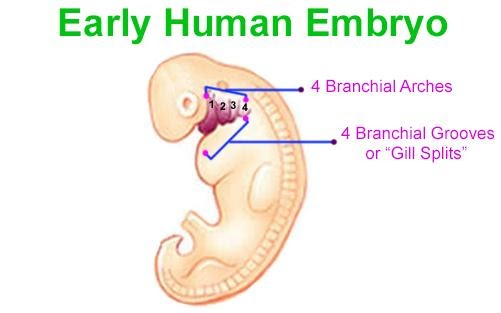
The early stage human embryo distinctly possesses
A) Gill
B) Gill slits
C) External ear (pinna)
D) Eyebrows
Answer
426.3k+ views
Hint: Human embryonic development or human embryogenesis refers to the development and formation of the human embryo. In sexually reproducing organisms, embryonic development begins just after fertilization and continues through the formation of body structures, such as tissues and organs.
Complete Answer:
Each embryo starts its development as a zygote which is a single cell resulting from the fusion of gametes. In the first stages of embryonic development, a single-celled zygote undergoes several rapid cell divisions, called cleavage and forms a blastula. Next, the cells in a blastula-stage embryo start rearranging themselves into layers. That process is called gastrulation. These layers each give rise to different parts of the developing multicellular organism, such as the nervous system, connective tissue and organs. Early human embryo possesses a dorsal hollow nerve cord, a well-developed notochord and a series of gill slits to sustain itself in the environment of the womb. These slits are found in embryos of all vertebrates because they share the common ancestry of fish in which these structures first evolved. In humans, they disappear before birth.
Note:
Between the head and the heart, a series of branchial arches, i.e., cartilaginous structures supporting the gills of fishes and larval amphibians, begin to form. In higher vertebrates, these structures form part of the jaw and the ear.

Figure: Gill slits in an embryo
Complete Answer:
Each embryo starts its development as a zygote which is a single cell resulting from the fusion of gametes. In the first stages of embryonic development, a single-celled zygote undergoes several rapid cell divisions, called cleavage and forms a blastula. Next, the cells in a blastula-stage embryo start rearranging themselves into layers. That process is called gastrulation. These layers each give rise to different parts of the developing multicellular organism, such as the nervous system, connective tissue and organs. Early human embryo possesses a dorsal hollow nerve cord, a well-developed notochord and a series of gill slits to sustain itself in the environment of the womb. These slits are found in embryos of all vertebrates because they share the common ancestry of fish in which these structures first evolved. In humans, they disappear before birth.
Note:
Between the head and the heart, a series of branchial arches, i.e., cartilaginous structures supporting the gills of fishes and larval amphibians, begin to form. In higher vertebrates, these structures form part of the jaw and the ear.

Figure: Gill slits in an embryo
Recently Updated Pages
Master Class 10 Science: Engaging Questions & Answers for Success

Master Class 10 Social Science: Engaging Questions & Answers for Success

Master Class 10 Maths: Engaging Questions & Answers for Success

Master Class 10 English: Engaging Questions & Answers for Success

Class 10 Question and Answer - Your Ultimate Solutions Guide

Master Class 9 General Knowledge: Engaging Questions & Answers for Success

Trending doubts
Give 10 examples of unisexual and bisexual flowers

Draw a labelled sketch of the human eye class 12 physics CBSE

Differentiate between homogeneous and heterogeneous class 12 chemistry CBSE

Differentiate between insitu conservation and exsitu class 12 biology CBSE

What are the major means of transport Explain each class 12 social science CBSE

What is the difference between resemblance and sem class 12 social science CBSE




